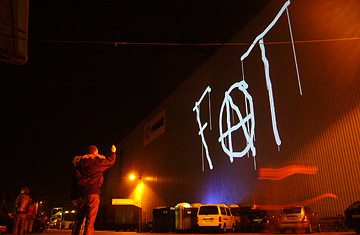
Artists James Powderly and Evan Roth recently went on a daring graffiti mission. The goal? Tagging New York's Brooklyn Bridge. They waited for rush hour to die down and tried to be as incognito as people milling around bridges can be in this post-Sept. 11 world. Then, the duo fixed their crosshairs firmly on the bridge's underside, and started etching out dozens — maybe hundreds — of tags on one of its massive supports. They held still as a police boat floated under the bridge. Later, they allowed passersby to pick up the equipment and try it for themselves. Yet, the next morning, there was nary a sign that Powderly or Roth — nor their towering graffiti art — had ever been there.
While most graffiti crews use spray paint to mark buildings and urban infrastructure, Roth and Powderly, the artists behind the Graffiti Research Lab, have perfected a unique form of temporary high-tech graffiti they call laser tagging that utilizes a laser pointer in lieu of paint, a projector in place of a spray. Instead of hitting dark subway tunnels and back alleys, they turn their attention to public places such as skyscrapers and monuments. A growing legion of fans turn out regularly to witness live demonstrations of their light shows (see video of their latest graffiti missions), but most log on en masse to watch videos of the events on such sites as YouTube and GraffitiResearchLab.com. A few hundred have even downloaded the needed computer code and instructions — something the "open-source" artists encourage people to do — to replicate Powderly and Roth's art in cities around the world. As a result of their soaring online popularity, the two artists have been sought out by a number of prominent curators in the art world — most recently by those at the Museum of Modern Art in New York — who see in their digital etchings a convergence of street art, graffiti art and urban cinema.
"The basic idea for laser tag was to create free-speech machines — to find ways of helping people say things at a scale and in a place where you normally have people controlling speech," Powderly says. "Doing it in an art museum was never the intent. Some days we think it's an art project, but other days it seems like an activism project, bringing together hackers and engineers."
The artists started laser tagging in earnest only a year ago; they devised the basic concept while art fellows at Eyebeam, an art and technology center in New York where Powderly and Roth refined their open-source technology. The system is simple: The duo will locate an appropriate building or structure (avoiding buildings with windows to prevent any accidental laser-eye injuries) and aim the projector at the surface; with each flick of the laser pointer, the computer software registers a streak of light (see the equipment). The artists have pointed their projectors at everything from bridges in New York City to miniature pyramids in Italy, high-rises in Hong Kong and snow-covered mountains just a few miles away from the Sundance Film Festival in Utah. Video of their work can be seen until May 12 in the current MoMA exhibit "Design and the Elastic Mind," an exhibition that kicked off with a live Graffiti Research Lab demonstration at the opening night reception.
"The best part was they agreed to let us have a really large guest list, so we invited 100 people, and put every graffiti writer we've ever worked with on the list, bringing them into the MoMA," Roth says. "When graffiti writers are arrested, it's at the judge's discretion what they are charged with, depending on whether they were acting as vandals or misguided artists. And by inviting all these people to MoMA, now if they ever get arrested, they can point to this video and say that of course they're artists, they've been featured by one of the country's most prominent institutions."
As evidenced by those unlikely guests at the MoMA opening — some of whom used the occasion to digitally spray comments mocking both the opening night crowd and the institution itself — the GRL seems to be inhabiting two worlds simultaneously. Powderly has called his laser tag device a "weapon of mass defacement." But their light art disappears with flip of a power switch, making it not necessarily illegal in some municipalities. "We talk about graffiti a lot," Roth says, "People view graffiti differently, some think of graffiti as an end design, but others think of it as an action, and by graffiti going online, you can see the action in progress."
"People say that we're high-tech," Powderly chimes in, "But I can't find a moment where [graffiti] wasn't high-tech. If you look back, you had spray cans — this form of technology that was a little too new to be considered an art form — and this billion-dollar transportation system that taggers used to spread their art. It's not all that different from laser pointers, a new technology, and this immense infrastructure that you find in urban areas."
